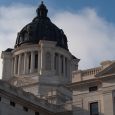The Gift of South Dakota
Subscriptions to South Dakota Magazine make great gifts!
Subscribe today — 1 year (6 issues) is just $29!
Can We Shoot for Second-Worst?
Jan 22, 2014
I have made this argument before. Sandy-eared ostriches in the Legislature require that I make it again, and again....
The South Dakota Legislature this week considered a resolution—not a practical, policy-changing bill, mind you, just a resolution—that acknowledges a shortage of teachers in South Dakota due in part to low teacher pay. HCR 1002 passed the House over some objection from Republicans with poor reading comprehension. No Senators spoke against the resolution, but the Senate killed it Tuesday 15‒19.
Evidently some problems are too brutal for a majority of Senators to talk about, let alone solve.
The teacher shortage resolution didn't explicitly call for raising teacher pay, but it should have. Recent data show South Dakota is last, last, last in teacher pay, stunningly last, 30 percent below the national average, 10 percent below 48th-ranked Oklahoma, and six percent below 49th-ranked Mississippi. According to 2013 Quarter 3 data, South Dakota's cost of living is only 0.5 percent below the national average.
HCR 1002 mentioned the drop in young people choosing to work in education in South Dakota. Who can blame them? Our perennially low teacher wages make it harder for South Dakota graduates to deal with another ongoing problem, our high rates of student debt. A new report confirms reports from 2010, 2011, and 2012: South Dakota college graduates lead the nation in student debt, with 78 percent of our graduates carrying student loans. Their average debt is "only" $25,121, a middling amount compared to other states. But for those hardy young souls who go into teaching, why would they pass up the chance to move one state in any direction and pay off their student loans much faster with an average $8,000 to $18,000 pay hike?
Why won't we invest? Why have we let ourselves be this cheap for this long?
Why don't we rouse a campaign to erase our shameful status of stiffing our teachers? Let's see teachers, parents and students marching down the streets arm in arm, crying "Forty-Ninth! Forty-Ninth!" Let's see candidates for governor and legislature vow, "We're not shooting for the moon, just Mississippi!" Pegging a minimum wage for 9,200-some South Dakota teachers to Mississippi's next-worst in the nation would take $22.4 million a year. It would take $42.1 million to beat Oklahoma. (Get out the Saturn V to reach Minnesota: we'd need $154.4 million, a 39 percent increase in Governor Dennis Daugaard's proposed state aid to K-12 for FY2015.)
Money doesn't grow on corn stalks. But South Dakota found a million dollars to hand to a floundering beef plant, even as the state faced a crushing $127-million deficit. This year the Governor is finding $30 million to pour into his economic development fund sooner than planned.
Where there's a will, there's a way. The debate over HCR 1002 shows that South Dakota lacks the will to even talk about being better than worst in paying teachers what they are worth.
Editor's Note: Cory Heidelberger is our political columnist from the left. For a right-wing perspective on politics, please look for columns by Dr. Ken Blanchard on this site.
Cory Allen Heidelberger writes the Madville Times political blog. He grew up on the shores of Lake Herman. He studied math and history at SDSU and information systems at DSU, and has taught math, English, speech, and French at high schools East and West River.









Comments
I think if there is a shortage of teachers in SD the salary will have to be increased at the beginning level to attract more in. Supply and demand will work when needed. A good line that I heard in an educational arguement was "show me a time in the last 30 years where an increase in salaries showed an increase in the educational performance of the students".
I think the above reporter previously stated the teachers pay was a certain per cent below the median income of SD. I do not know that, but again in my time a lot of people taught because they enjoyed the the 4 months off. They had the choice to do with that time whatever they wanted.
Parents are the most important part of the educational system A great teacher is super when that happens, you can learn from any teacher and parents input is required to obtain good performance. The educational system especially through grade 12 will function as well as the parents want it. The parents have to know that....
Supply and demand works, but sometimes it's a bit slow on the draw. I'd rather we invest now to avoid having to engage in some crash course to replenish the teaching ranks.
Four months off is at least a month too high and a red herring. Whatever time you think teachers get off, they get that time off pretty much everywhere. That's not a decision point for teachers choosing between South Dakota and Wyoming. Pay is.
"...you can learn from any teacher..." Jon, is that belief why South Dakota pays teachers so little? Do we really believe we can just sit kids in any classroom with any supervision, or maybe with just a computer, and they'll all learn well enough?
People don't become a teacher unless they want to work hard. Teachers show up hours before school starts, and stay hours after it ends. Many coach sports teams after school and then go home to grade papers. It amazes me how little appreciation people have for those who educate, and for many, play an integral role in raising our state's kids. If anyone deserves a raise, it is our educators.
Of course, since the local teachers unions have required that all teachers be paid according to a set pay schedule, that leaves the district no flexibility to pay high demand teachers more or to offer bonuses. In essence, the teachers unions are driving the shortages, and using it a club to demand more pay for all teachers.
And for the record, the vast majority of teacher do not "work" during the summers at professional development or school meetings--it just does not routinely happen. So stop with the baseless claims.
If any one deserves a raise, it's teachers in high demand content areas in remote geographical regions.
That must be what's occurring now if you are correct.
1. According to you, SD is not paying enough to attract quality teachers.
2. Standardized testing indicates that SD students are performing well; certainly well above average.
Based on those two factors, SD students are learning from underpaid and increasingly unqualified teachers.
Right? Or are you wrong about something?